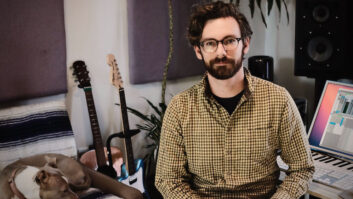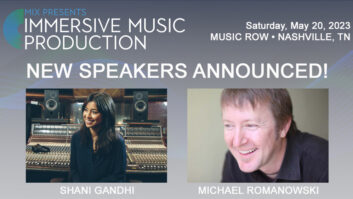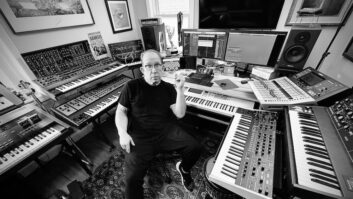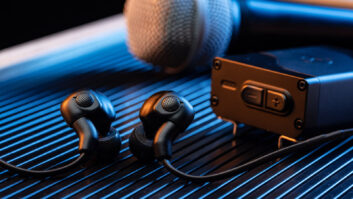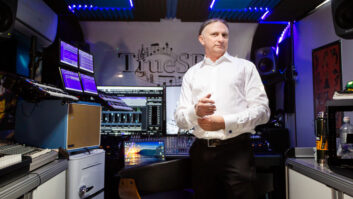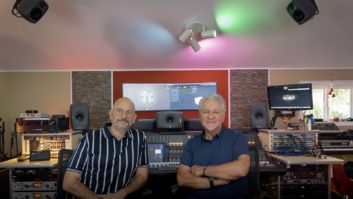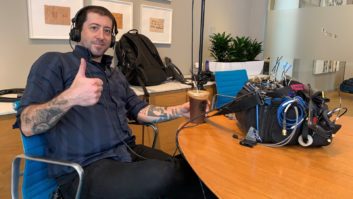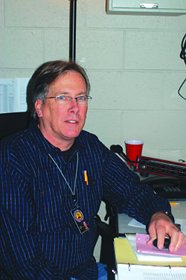
Here we go again. How are things going in 2011?
Well, so far so good. We are now midday, second day of rehearsals. We started out with Arcade Fire, the white P-Funk as somebody coined them. And then we went right into Barbra Streisand, who was just fabulous, so professional from the first note. Her engineer, Dave Reitzas, was a real pleasure to work with.
This is my 25th year on the show, 10 years of coordinating. I’ve done Radio City, the Garden, and I’m happy to be home here at Staples. Staples is, if not the best facility, one of the best. This show requires a huge amount of collaboration and the Staples team is just wonderful.
Anything new this year?
Not much from the equipment side. They’re using PowerSoft amps to power the [JBL] VerTec P.A., but they’re not using the new DSP processors yet. This show is all about communications, and I do everything in my power to keep above the flow of information and disperse it to the 40 or so technicians among the six mix positions and all their assistants. We are for the first time using Google Docs to simplify the flow of information. The discipline of that has been rather interesting. [Laughs] We did a first test on Super Bowl Sunday, where I sent out a burst to the team of 40, and now I find out these guys have 20 other e-mails that I didn’t know about all linked to Google. But it’s been great here on-site, where mic inputs might be updated right up until showtime.
You keep saying “complexity” and “simplicity.”
The RF and the IT data streams on this show are on a par with the audio, in terms of splits and inputs. We probably have the most extensive distribution of audio signals of any show on television, any live show. This is a very unique musical show, and the diversity and the dynamics are very wide. The type of inputs or connectivity or data that we distribute ranges from MIDI to WiFi to RF to MADI to AES to ZigBee 2.4 protocol—you name it, we’re dealing with it.
The complexity in my view is in the RF spectrum. I do everything to keep my arms around it, and I have one of the best guys in the business to drive that: Dave Bellamy, our RF coordinator.
Talk to me about RF.
It’s not so much diminishing returns. It’s just that the spectrum is being repopulated and our spectrum is being diminished, and within that spectrum we have to concentrate the same amount or more usage than we did last year or the year before. We try to accommodate everybody on the show with the types of mics they use, and some of our manufacturers, within their RFs, have different types of models that work in multiple formats with a single receiver. One of the issues I’m trying to address with manufacturers is how do you develop hardware that works for a dynamic show like this? This show is highly dynamic, minute to minute, sequence to sequence, and over the three days, as we build to the show, you have 20 bands so you have 20 segments, with maybe 10 different mics used in the same receiver. So you have compander circuitry, you have different types of transmitters. Everything that you can imagine to complicate the chain. It’s definitely not, “Turn a mic on, turn a mic off.”
Do you clear the area?
This room is essentially an anechoic environment, and that helps immensely. But we do a survey two weeks prior, then a week out, and at that point Dave is mapping out what he’s doing. And he has to coordinate with the PL communictions teams. There’s some microwave cameras walking around. We have a zero tolerance for wandering wireless. We post signange indoors and outdoors for ENG. We don’t have as elaborate a method or as strict as James at the Super Bowl. It’s just flat-out zero tolerance. I work very closely with pre-show, post-show, the press on-site and make sure that nobody is firing up RF. That seems simplistic, but somebody will turn on no matter what you do.
I work closely with AudioTek, our primary sound vendor, and MCR Broadcast, and Denali Summit, our primary broadcast truck, along with Music Mix Mobile for the music mix and Soundtronics for the RF coordination.
You’ve told me before that you base your year around Grammy night. What is it about live TV that excites you?
Nothing beats the spontaneity of live. We’re going along and anything could happen. A mic might die. We’ve got contingencies. But the bottom line is that you don’t lock up, you keep moving forward. You put a plan in place on something of this magnitude. Then we get to dress rehearsal and see whether the plan is working. But my job is, prior to that, knowing that maybe John Robinson’s drum kit is going to be used for Barbra Streisand, which has a huge string section. But then we’re also going to turn around and use that same drum kit for an Aretha Franklin tribute. This is a big one. [His phone rings for the fourth time.] That’s the creative process changing right now.

